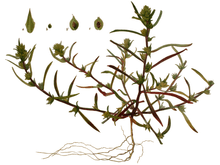Corispermum hyssopifolium
| Corispermum hyssopifolium | |
|---|---|
 | |
| Corispermum hyssopifolium, as illustrated in Flora Batava by Jan Kops | |
| Scientific classification | |
| Kingdom: | Plantae |
| (unranked): | Angiosperms |
| (unranked): | Eudicots |
| (unranked): | Core eudicots |
| Order: | Caryophyllales |
| Family: | Amaranthaceae |
| Subfamily: | Chenopodioideae |
| Genus: | Corispermum |
| Species: | C. hyssopifolium |
| Binomial name | |
| Corispermum hyssopifolium L. | |
Corispermum hyssopifolium is a species of the Corispermum genus, belonging to the Amaranthaceae family. It is found in dunes and sandy spots along rivers in central and western Europe, and in western North America [1] where it was exploited for its edible seeds prehistorically. An annual plant, it is between 10 and 60 centimeters (3.9–26.3 inches) high. It blooms in July and August. The fruits have narrow wings, of which the nontransparent edge becomes wider at the top, and on which spikes are mounted on a broad base each. The transparent half of the edge is narrow. The top stipules are ovate, with a peaked top.[2]
References
- ↑ Betancourt, J. L.; Long, A.; Donahue, D. J.; Jull, A. J. T.; Zabel, T. H. (1984-10-18). "Pre-Columbian age for North American Corispermum L. (Chenopodiaceae) confirmed by accelerator radiocarbon dating". Nature. 311 (5987): 653–655. doi:10.1038/311653a0.
- ↑ N.K.A. 51. 1941, p.447
This article is issued from
Wikipedia.
The text is licensed under Creative Commons - Attribution - Sharealike.
Additional terms may apply for the media files.